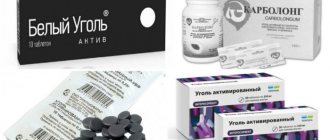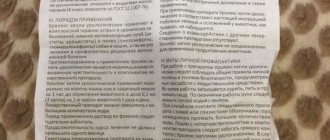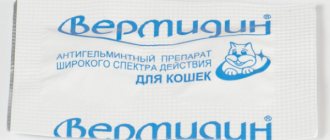Form and composition
Stomorgyl is available in tablets. They are packaged in blisters and placed in cardboard packaging with instructions for use.
The medicine consists of active ingredients:
- metronidazole;
- spiramycin.
Stomorgyl is available for sale in 3 types with different ratios of the main components:
- Stomorgyl 2 (weight 120 mg): spiramycin – 150 thousand IU, metronidazole 25 mg;
- Stomorgyl 10 (weight 600 mg): spiramycin 750 thousand IU, metronidazole – 125 mg;
- Stomorgyl 20 (weight 1200 mg): spiramycin 1,500 thousand IU, metronidazole 250 mg.
The drug additionally contains: aluminum hydroxide – 4%, sorbitol – 2%, white dextrin – 0.15%, gelatin – 0.25%, magnesium stearate – 1%, starch – 90%.
Stomorgil
Instructions for use of the drug Stomorgil 2, 10 and 20 for the treatment of infections of bacterial etiology in dogs and cats (developer organization, France)
I. General information Trade name of the drug: Stomorgyl 2, 10, 20 (Stomorgyl 2, 10, 20). International nonproprietary name: spiramycin and metronidazole.
Dosage form: tablets. The drug as active ingredients, depending on the dosage, respectively contains:
- Stomorgyl 2 (120 mg tablet) - spiramycin 150,000 IU and metronidazole 25 mg;
- Stomorgyl 10 (tablet weighing 600 mg) - spiramycin 750,000 IU and metronidazole 125 mg;
- Stomorgil 20 (tablet weighing 1200 mg) - spiramycin 1,500,000 IU and metronidazole 250 mg;
as well as auxiliary components: aluminum hydroxide - 4%, sorbitol - 2%, white dextrin - 0.15%, gelatin - 0.25%, magnesium stearate - 1% and starch - up to 100%.
The drug is released in blisters packed in cardboard boxes.
Store the drug in the manufacturer's sealed packaging, separate from food and feed, in a dry place, protected from direct sunlight, at a temperature from 0°C to 25°C. The shelf life of the medicinal product, subject to storage conditions, is 3 years from the date of production. It is prohibited to use Stomorgil 2, 10, 20 after the expiration date.
Stomorgyl 2, 10, 20 should be stored out of the reach of children.
Unused medicinal product is disposed of in accordance with legal requirements.
II. Pharmacological properties Stomorgil 2, 10, 20 refers to combined antibacterial drugs. Thanks to the combination of its active components, it has a wide spectrum of action against gram-positive and gram-negative microorganisms.
Spiramycin is an antibiotic of the macrolide group; it has bacteriostatic activity, reversibly binding to the 50S ribosomal subunit, and inhibits protein synthesis in the microbial cell. Active against gram-positive and some gram-negative microorganisms, including Staphylococcus spp., Streptococcus spp., Clostridium spp., Corynebacterium, Actinomyces, Bacteroides and Mycoplasma spp.
When administered orally, it is quickly adsorbed in the gastrointestinal tract and diffuses well into biological fluids (including saliva), organs and tissues. The maximum concentration of spiramycin in blood plasma is observed after 4-6 hours, in saliva - after 4-8 hours.
Metronidazole is an antiprotozoal agent from the nitro-5-imidazole group. Active against anaerobic microorganisms, including Bacteroides spp., Clostridium spp., Fusobacterium, suppresses the development of protozoa, including balantidia, trichomonas, lamblia and amoebae. After oral administration, metronidazole is rapidly and almost completely absorbed from the gastrointestinal tract, reaching maximum concentrations in plasma and saliva after 1 hour. Metabolism occurs in the liver by oxidation and binding to glucuronic acid.
Stomorgyl is used to treat infections caused by staphylococcus, streptococcus, and clostridia. Stomorgyl is also effective in the treatment of mycoplasmosis in cats and dogs, trichomoniasis, amebiasis, giardiasis and other protozoal diseases.
The active components of the drug are excreted from the body mainly with urine and partly with feces, and in lactating animals also with milk.
In terms of the degree of impact on the body, Stomorgyl 2, 10, 20 belongs to moderately dangerous substances (hazard class 3 according to GOST 12.1.007-76), in recommended doses it does not have a sensitizing, teratogenic or embryotoxic effect.
III. Directions for use Stomorgyl 2, 10, 20 is prescribed to dogs and cats for the treatment of bacterial infections caused by microorganisms sensitive to metronidazole and spiramycin, and primarily infections of the oral cavity, including periodontal diseases, stomatitis, gingivitis and pyorrhea.
A contraindication for use is the animal’s hypersensitivity to the components of the drug (including a history of it). Animals with severe heart, kidney and liver diseases should use the drug with caution under the supervision of a veterinarian.
Stomorgyl 2, 10, 20 is administered to dogs and cats individually orally once a day at a dose of 75,000 IU of spiramycin and 12.5 mg of metronidazole (active ingredients) per 1 kg of animal weight, based on:
- 1 tablet of Stomorgil 2 - per 2 kg of animal weight;
- 1 tablet of Stomorgil 10 - per 10 kg of animal weight;
- 1 tablet of Stomorgil 20 - per 20 kg of animal weight.
The duration of treatment, depending on the condition of the animal, is 5-10 days and is determined by the attending veterinarian.
Tablets of the drug should not be used in crushed form; the tablet may be divided into parts only according to the mark on it.
In case of an overdose, animals may experience excessive salivation, gastrointestinal upset, and a depressed state.
No peculiarities of action were identified during the first use of the drug and when it was discontinued.
If you miss another dose of the drug, the course of use must be resumed as quickly as possible at the same dose according to the same regimen.
Side effects and complications in animals when using the drug in accordance with these instructions, as a rule, are not observed. If allergic reactions occur in an animal sensitive to the components of the drug, its use is stopped and antihistamines and symptomatic drugs are prescribed.
Stomorgyl 2, 10, 20 should not be used simultaneously with other macrolide antibiotics.
Stomorgyl 2, 10, 20 is not intended for use in productive animals.
Pharmacological properties
The main substances of the medicine are strong antibiotics that can completely kill the organisms of such microbes as:
- staphylococci;
- streptococci;
- meningococci;
- chlamydia;
- clostridia;
- Trichomonas;
- Helictobacter pylori;
- mycoplasmosis.
Metronidazole prevents bacteria from breathing. The component immediately enters the bloodstream in full through the walls and vessels of the stomach and intestines. High concentrations in blood plasma and saliva occur within 60 minutes.
Spiramycin is a natural antibiotic that prevents bacterial cells from growing and developing. It is quickly absorbed into the cat's intestinal walls. The maximum concentration in blood plasma is reached after 3-5 hours, and in saliva - 3-7 hours.
Together, these two components prevent bacteria from developing and multiplying and lead to their inevitable death.
The medicine leaves the cat’s body naturally, the vast majority through urine or feces. If the cat is feeding its offspring, the drug will be partially excreted in the mother's milk.
When is the medicine prescribed?
Stomorgyl is prescribed for infections of bacterial origin that are sensitive to Metronidazole and Spiramycin. Taking the medicine is possible and effective at any stage of the disease, but it is recommended to start treatment in the initial or acute period.
The complex use of Stomorgyl with other drugs in the fight against various diseases of the oral cavity (for example, stomatitis, gingivitis, periodontitis and others) enhances their effect.
It should be noted that the effectiveness increases when these diseases are caused by pathogenic bacteria sensitive to Metronidazole and Spiramycin.
The product perfectly helps with bleeding gums, prevents the appearance of plaque, as well as during surgical interventions in the oral cavity. It is worth noting that if the mucous membrane is treated with this drug, it can be considered sterile.
Dosage of the drug
When treating a pet with the drug Stomorgyl, the dosage is determined individually by the veterinarian, or in accordance with the instructions:
- Stomorgyl 2 for cats weighing up to 2 kilograms is prescribed 1 tablet.
- Stomorgyl 10 for an animal weighing 5 kilograms is prescribed half a tablet. If the animal weighs 10 kilograms, you should take 1 tablet.
- If the cat weighs close to 15 kilograms, half a tablet of 1200 mg is prescribed. If the animal weighs 20 kilograms, then the whole tablet should be taken.
At any dosage, administration is carried out once every 24 hours. It is worth noting that crushing the tablet is unacceptable; it is only allowed to divide it in half. Divide the tablet only if it is obvious that the cat will not be able to swallow it whole. Stomorgil has an unpleasant bitter taste.
If the drug is crushed, its particles may remain in the animal’s mouth and thereby cause an unpleasant impression and sensation from the treatment procedure.
The course of taking the medicine is from 5 to 10 days and depends on the complexity of the disease and the characteristics of the animal’s body.
Adverse reactions
The medicine is well tolerated by “patients” and does not lead to negative reactions.
Side effects may be caused by intolerance to the main components of the drug Stomorgyl. In this case, the cat will experience:
- allergic reactions;
- vomit;
- diarrhea;
- increased salivation.
If undesirable consequences occur during use, you should immediately stop taking it and consult a specialist. The veterinarian will help you find an alternative solution.
If allergic manifestations occur, use continues in combination with antihistamines.
In case of overdose, you can observe: increased secretion of saliva, disorders of the nervous system and gastrointestinal tract. This situation requires immediate consultation with a veterinarian.
No particular effects of the drug were detected during initial use or upon its discontinuation.
The course of treatment should be carried out according to the instructions, or individually prescribed by the attending veterinarian, and interruptions in use should not be allowed if the drug has a positive effect. If the drug was interrupted, it is necessary, if possible, to restore it and continue according to the same regimen.
The medicine is eliminated from the body within 3 days.
Contraindications for use
According to the instructions for use, Stomorgyl is prohibited from being used in combination with other antibiotics. You should also stop taking it if your body is hypersensitive to the components of the antibiotic.
Taking the medication is not contraindicated during pregnancy and lactation. However, in case of heart, kidney and liver failure, treatment is carried out only after consultation with a specialist and under his supervision.
Features of use in cats
The antibiotic is given to cats before meals, as otherwise vomiting can be provoked. The drug cannot be crushed, you can only cut the tablet into 2 parts. To make the task easier, you need to ask someone to help. First, you should wrap the cat in a towel so that it cannot scratch.
It is good for another person to hold the head and paws. Using a gentle movement of your index finger and thumb, you need to slightly open the cat’s mouth and place the tablet closer to the root of the tongue, otherwise the animal will spit out the medicine. Then release the pet, giving him the opportunity to drink water.
The correct position of the cat and the person is a guarantee that the tablet will be quickly swallowed by the animal
There is one clever trick that allows you to give an animal a pill and be sure that it will swallow the medicine. However, this manipulation will only work with cats. It is necessary to place the tablet on the pet's tongue and then blow lightly into his nose (without touching his lips), as a result of which the swallowing reflex will work and the medicine will pass into the esophagus.
I recommend that everyone give the pill to their cat only with the help of another person. It is very difficult to do this on your own, as I have seen from personal experience. It is important that another person holds the animal tightly, otherwise bites and scratches cannot be avoided, especially if the cat is hyperactive. When it was necessary to give my pet pills, I always did it together with someone. I asked my friend to hold the animal in her arms while I gently opened its mouth with my index finger. Then the cat reflexively opened its jaws, and I literally threw the pill onto the root of the tongue. The main thing here is not to hesitate, otherwise the animal will quickly close its mouth, and it will be very difficult to carry out the manipulation again. After such tests, it is advisable to praise your pet for its patience and give it some water to drink.
How to give a cat a pill - video
Dosage and duration of therapy
The dose of the medicine depends on the pet’s body weight and is calculated in such a way that per 1 kg of weight there should be 75,000 IU of an antibiotic (spiromycin) and 12.5 mg of an antiprotozoal component (metronidazole). The duration of treatment depends on the severity of the disease and is determined by the doctor. Usually the course does not exceed 10 days.
Features of treatment of pregnant cats and kittens
Pregnant and lactating females are allowed to take the drug only after consultation with a veterinarian and short courses not exceeding 5 days. The dosage is determined only by the doctor, based on the weight and age of the pet. The medication is not used to treat kittens whose body weight does not exceed 1 kg.
The drug should not be given to newborn kittens.
Drug interactions
During treatment with this drug, other antibacterial drugs are not prescribed.
Adverse reactions and contraindications
In most cases, the medication is well tolerated. Rarely, an allergic reaction may occur, the symptoms of which can be controlled with antihistamines. Sometimes, immediately after taking the tablet, the cat develops increased salivation, which quickly goes away without special treatment. In rare cases, vomiting and stool upset occur, this is especially possible during therapy with large doses.
When you should not give this drug to cats:
- if the body is weakened;
- with poor tolerance to antibiotics;
- if an allergic reaction of unknown origin is present;
- in the presence of severe cardiac pathologies, renal and liver failure.
While taking the drug, your cat may develop an allergy
If during treatment with an antibiotic a cat develops a rash on its body, itching appears, and hair falls out rapidly, you should immediately consult a doctor.
Precautionary measures
After the first dose taken, it is necessary to monitor the reaction of the animal’s body. If there are no alarming symptoms, then treatment can be continued. In addition, after each contact with the tablet, you must wash your hands thoroughly with soap. What other rules need to be followed:
- Do not try to force the tablet down the animal's throat. The medicine is placed only on the root of the tongue.
- Do not give the drug immediately after feeding the cat.
- Do not exceed the indicated dose.
- If for some reason the next tablet is missed, it must be given to the pet immediately. The next appointment should be within 24 hours.
- If there is no positive dynamics within 5-10 days, you must contact your veterinarian to change the medication.
- Do not press on the animal’s tongue with your fingers, so as not to provoke a gag reflex.
- To facilitate the passage of the tablet, you should first moisten it in water or a small amount of vegetable oil.
Note to owners: if you give your pet an antibiotic with food, the rate of absorption of the active components will slow down, which will negatively affect the effectiveness of the drug.
Storage conditions and price
The medicine should be stored in a place away from direct sunlight and with air humidity of no more than 50%, at a temperature range of 4 to 25 degrees, in intact packaging. The drug should be out of reach of children and pets; contact with food and feed should be avoided.
The shelf life is no more than 3 years, subject to all the above conditions. After the expiration date, the medicine should not be used. Unused drug must be disposed of in accordance with the requirements of regulations on the destruction of drugs and medicines.
On average, the price of the drug is 500-1500 rubles and depends on the dose of the drug.
Dosage
The dose is calculated for each animal by a veterinarian or you can act in accordance with the instructions for use. Special series of medications have been developed for cats of different ages and weight categories: Stomorgyl 2 is prescribed one tablet to cats whose weight does not exceed 2 kilograms. Stomorgyl 10 is given one tablet to a cat weighing 10 kilograms or more. If the weight is 3-5 kilograms, half a tablet is prescribed. Stomorgyl 20 in the amount of one tablet is prescribed for cats whose weight exceeds 20 kilograms. If the pet’s body weight is from 15 to 19 kilograms, the dosage is reduced to half a tablet.
Advice! Only a veterinarian will be able to accurately calculate the dose in accordance with the animal’s age, health status, and weight.
Treatment lasts 5-10 days. It all depends on the complexity of the pathology and the health status of the pet.
Administration of medication to an animal
While taking the medicine, those around you should remain calm, talk quietly to the cat, and pet it. Excitement and anxiety can frighten the animal and make it wary. If the owners are not confident in their actions, then it is better to use the help of a specialist.
The approach to the animal should be individual, depending on the nature of the pet: calm or hot-tempered.
Some tips:
- The process must take place with the participation of at least 2 people, one will hold the head, the second the animal.
- The cat's head needs to be tilted back a little.
- Press your fingers on the gum where the teeth are missing to release the lower jaw.
- For better glide, the tablet should be dipped in vegetable oil.
- Place the tablet on the root of the tongue.
- Pour water into the animal's mouth for a sip.
In order to make the procedure as safe as possible, you need to use a blanket, or purchase a special cage for this purpose at the veterinary store.
When working with this medicine, you should be guided by the principles of personal hygiene and safety precautions. Before using the medicine and after it, you should thoroughly wash your hands with soap and water.
For people who are highly sensitive to the components of the drug, it is necessary to avoid direct contact with the drug . If an allergy occurs or the medicine is ingested, you must urgently seek help from the hospital. Doctors must provide instructions for the drug or a box of it.
Contraindications and precautions
Stomorgyl is well tolerated by cats. However, you should be aware of contraindications to the use of this drug. Side effects include vomiting and increased salivation, diarrhea and an allergic reaction, which manifests itself in profuse lacrimation and itching. If at least one sign of overdose or side effect occurs, you must immediately contact your veterinarian and stop self-medication. After the examination, the doctor prescribes antihistamines and changes the antibacterial treatment regimen.
The drug should not be combined with other antibacterial drugs, as this may cause intoxication. The drug is not prescribed for known intolerance to certain components, heart disease, kidney disease or liver disease. The drug is not contraindicated for pregnant and lactating cats.
Most often, the drug Stomorgyl for cats is used in cases of problems in the oral cavity. This is because when taking the drug, it enters not only the circulatory system, but also the saliva, and therefore such a drug works well for bacteriological diseases of the oral cavity.
Read reviews about Stomorgil for cats - practice shows that veterinarians very often prescribe it for simple stinky breath in a cat.
This is because in more than half of the cases the cause of this problem is the proliferation of bacteria in the oral cavity, which is often found in cats that spend a lot of time outside, and with other, non-domestic animals.
In some cases, Stomorgyl can act as an auxiliary drug, while the main task will be to solve the problem that caused the disease in the oral cavity.
Stomorgyl is generally well tolerated by cats. However, you need to know about contraindications and precautions. In some cases, after taking the medicine, your pet may experience vomiting, increased salivation, diarrhea, allergies (watery eyes, the cat is constantly itching and licking). In this case, stop treatment and contact a veterinarian.
After the examination, the doctor will give an antihistamine and then prescribe analogues of the drug. The drug cannot be used simultaneously with other antibiotics. Otherwise, the cat will develop intoxication. The medicine is not prescribed if there is an intolerance to the components of the medication, or if the pet has problems with the heart, blood vessels, liver and kidneys. Stomorgyl is not contraindicated for pregnant and lactating cats in the prescribed dosage.
We invite you to read: How to care for a British kitten: education and maintenance











